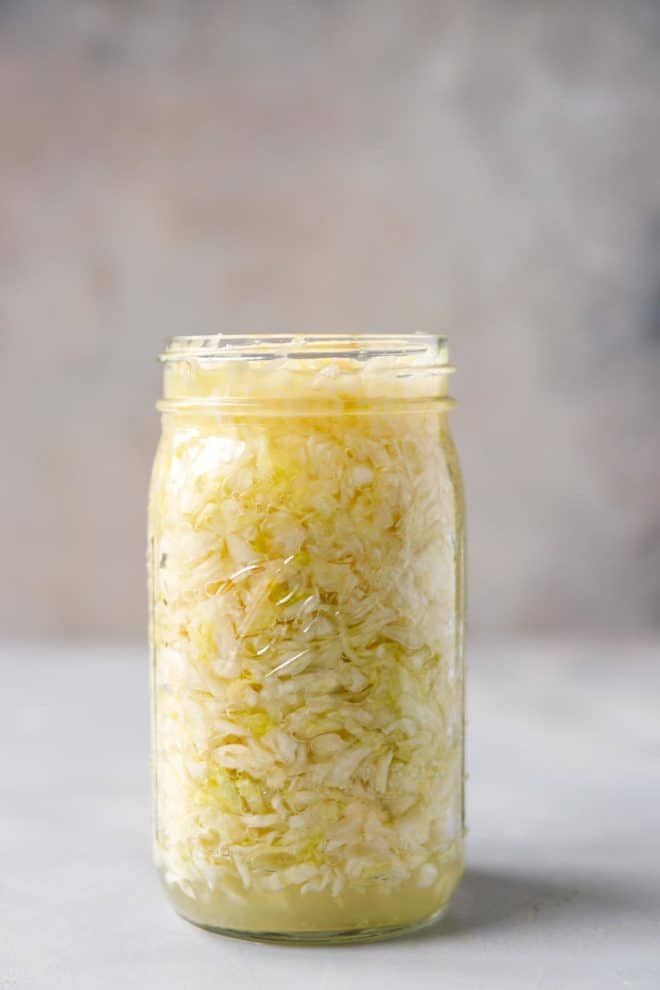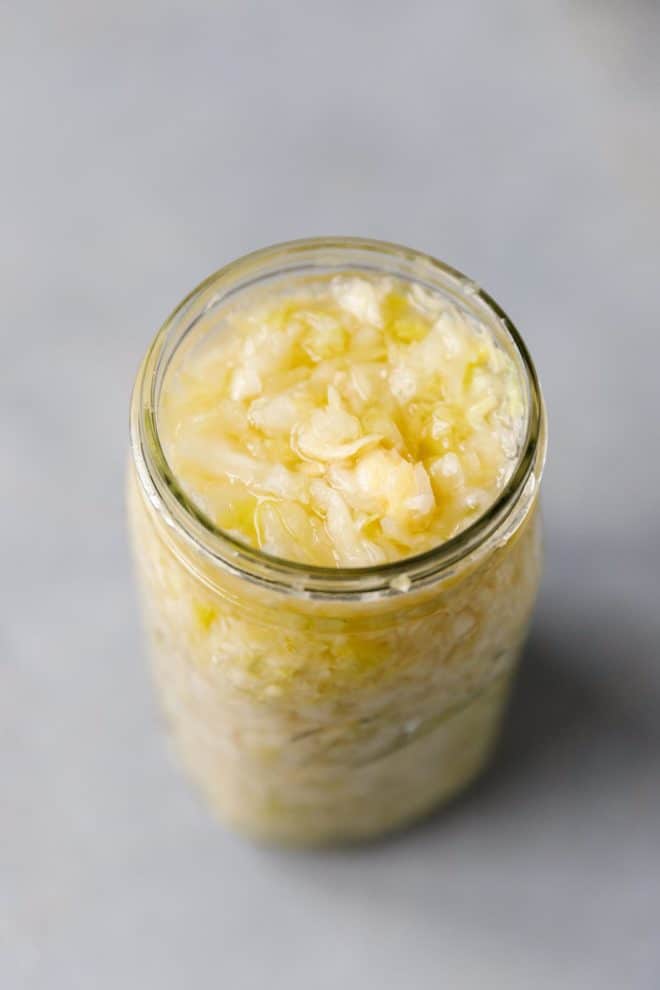This post may contain affiliate links. Please read our disclosure policy.
Easy Fermented Cabbage In A Jar – a simple and effortless way to prepare your own fermented cabbage at home. Use in salads, soups, sandwiches, wraps or cook it with meat and other veggies for a healthy, tangy and flavorful meal.

Love sauerkraut? Don’t have luck finding it at the store year round? Or you just want to make your own? You are at the right place. I do like fermented cabbage or sauerkraut and love using it in recipes. Growing up i Eastern Europe, my grandmother used to make her own sauerkraut in late fall and cook with it throughout the winter.
I like to make fermented cabbage in jars, because it is pretty quick, simple and foolproof process. Then I use it to make salads or cook it with some pork. It tastes super delicious.
Why make fermented cabbage?
What is sauerkraut? Sauerkraut is fermented cabbage.
It is rich in fiber, vitamins and minerals. Sauerkraut promotes the growth of probiotics and its nutritional value is enhanced through fermentation.
Fermentation of cabbage – it is done through a process called “Lactic Acid Fermentation”, similar to how Kimchi (Korean fermented cabbage) is made. Sauerkraut is sliced, layered with salt and (or) water and left to ferment.
Fermentation by lactobacilli is introduced naturally, as these air-borne bacteria culture on raw cabbage leaves where they grow. Yeasts also are present, and may yield soft sauerkraut of poor flavor when the fermentation temperature is too high. Fermentation has three stages. For more information check Wikipedia.
Difference between pickled and fermented cabbage
The important difference between pickled and fermented vegetables is that pickling involves putting food into an acidic brine to produce a sour flavor, whereas fermenting gives food a sour flavor without any added acid.
Pickled cabbage – this method does not require fermentation. I’m sharing with you the way I make pickled cabbage (and I sometimes use the exact same method for pickles).
Cabbage is thinly sliced and combined with a marinade, usually made of vinegar, water, salt and black pepper, herbs and sometimes sugar. The marinade could be hot or cold. Let the cabbage sit in the marinade for 2 hours or refrigerate for up to 48 hours. Pickled cabbage will not go bad for up to 2 weeks, if kept in an airtight container in the fridge.
Looking for more pickling recipes? You may want to check these out:
Fermented cabbage also known as sauerkraut is finely cut cabbage, that has been fermented by lactic acid bacteria.
It has a distinctive sour flavor, as a result from the lactic acid formed when the bacteria ferment the sugars in the cabbage leaves. A very important ingredient in the fermentation process is salt. It is the ingredient that makes fermented cabbage tasted great. The amount of salt is very important. Please make sure you follow the recipe directions and measure correctly the amount of salt needed for the amount of cabbage you are making.

What to use this sauerkraut in a jar for?
This sauerkraut in a jar is good for salads, sandwiches, use as a side dish to your meal, in grain bowls or cook it with some meat (like pork or chicken thighs), like I did here: Slow Cooker Pork And Sauerkraut.
Ingredients
- Cabbage (either green or purple).
- Salt – preferably sea salt, because using Iodized salt might slo down the process. Himalayan (pink or white ) salt could be also used for fermenting.
- Filtered Water
You also need a large jar with a lid, to fit the cabbage inside.
How to make
Like most “fermented” recipes, this fermented cabbage in a jar requires some time. Fermentation of cabbage (cabbage should be sliced and in a jar) does take about 10-14 days. If you are fermenting whole heads of cabbage, in a large container, it will take even longer. This post is only about making sauerkraut in a jar in the comfort of your home.
Make sure everything is washed and clean (cutting board, knife, jar and lid).
Cut cabbage and place it in a bowl.
Sprinkle salt and massage for 5 minutes. Cabbage should get sort and start to release liquid.
Pack into jar(s), press with weights on top and cover loosely. wait for 24 hours for the cabbage to release more liquid.
If the liquid released is not enough to cover the cabbage completely, add additional salted water.
For each cup of filtered water, add 1 teaspoon of sea salt.
Pour the liquid over the cabbage to make sure it is submerged in liquid.
Top with weights, then loosely cover.
Let the cabbage ferment at a temperature between 60-75 F, away from direct sunlight for 3-14 days.
After day 3, start checking for doneness. When cabbage reaches the desired taste, remove the weight, screw on the lid and refrigerate for up to 2 months.
More Cabbage Recipes:
- Fried Cabbage With Bacon – Quick to make with minimal prep work, this cabbage with bacon is perfectly cooked and makes a great weeknight dinner.
- Keto Cabbage Soup Recipe – very quick and easy to make, nutritious and delicious soup made with cabbage, ground beef and tomatoes.
- Easy Purple Cabbage Salad – an antioxidant packed, light, fresh and delicious, vibrant, crunchy and nutty bowl of goodness.
- How to steam cabbage – in this blog post from Cooktoria, you will learn how to make soft, garlicky and delicious steamed cabbage.

Easy Fermented Cabbage In A Jar
Video
Ingredients
- 1 head of green cabbage, 3-4 lb
- 1 1/2 tbsp Kosher salt or 1 tablespoon fine sea salt
- More salt + filtered water
- To extra liquid, if needed for every 1 cup filtered water add 1 teaspoon of sea salt, stir to dissolve.
Instructions
- Prepare for the fermenting process. Make sure the jars, knives and cutting boards are clean and dry, to ensure a proper fermentation of the cabbage.
- Place cabbage on a cutting board, remove the outer leaves. Cut in half, then in quarters, cut off the core. Thinly slice cabbage.
- Place cabbage in a large bowl.
- Sprinkle salt over it. Using your hands, squeeze and massage the salt into the cabbage.
- Add cabbage to the jar(s). Pack it tightly. Pour any liquid released while massaging the cabbage.
- If you have clean stones, weigh down the cabbage, to keep it in the liquid.
- Cover the jar , but don’t close tightly. You can use the lid, but don’t tighten it, or cover with cloth and secure with a rubber band.
- The cabbage will continue releasing liquid in the next 24 hours. You can press it down from time to time.
- If the liquid released, has not risen above the cabbage after 1 day, add more liquid.
- For every 1 cup of water, add 1 tsp of salt. Add the liquid to the jars to submerge the cabbage.
- Ferment for 3-14 days. It usually takes me 10-11 days to reach the desired taste.
- Keep the jars preferably at a temperature between 60-75 F and away from direct sunlight. The cooler the temperature, the better, but the fermentation process might take a little longer.
- Start tasting the fermented cabbage after day 3 and when it tastes right to you, remove the weight and close the lid on the jar. Keep in the fridge for up to 2 months.
Nutrition
Nutrition information is automatically calculated, so should only be used as an approximation.

GREAT IDEA ! NEVER THOUGHT OF DOING THAT !
Hi there.
It’s a great source of inspiration for living healthy.
The bacteria from fermented cabbage is pure “life”. I have a question: if I don’t have filtered water may I use cool boiled water? or what else?
Thank you very much.
Regards,
Cris.
Hi,
Yes, you can boil water, then cool it and use in the recipe.
I’m from POLAND and I’m so happy your recipe!! We love fermented vegetables like cabbage, cucumbers. We can make sour everything!!! Garlic, raddish, watermelon, tomatoes, cauliflower, broad beans, daikon and so mich more 😊
Thank you!